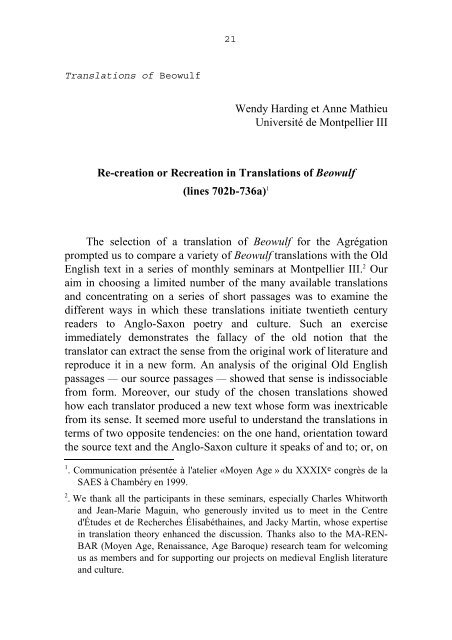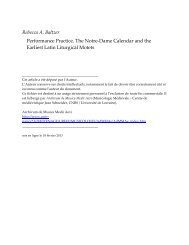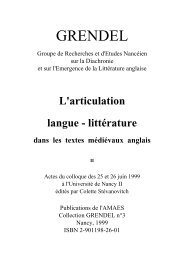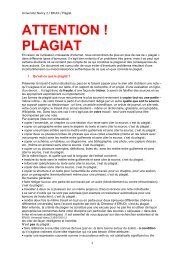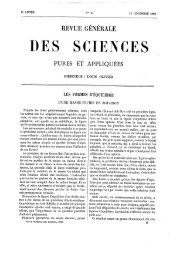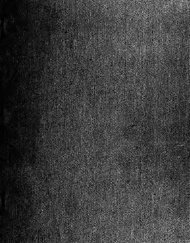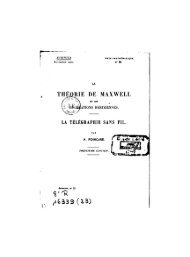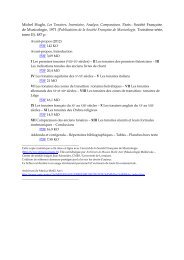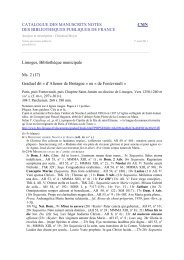3Harding-Mathieu - Université Nancy 2
3Harding-Mathieu - Université Nancy 2
3Harding-Mathieu - Université Nancy 2
You also want an ePaper? Increase the reach of your titles
YUMPU automatically turns print PDFs into web optimized ePapers that Google loves.
Translations of Beowulf<br />
21_(12U<br />
Wendy Harding et Anne <strong>Mathieu</strong><br />
<strong>Université</strong> de Montpellier III<br />
Re-creation or Recreation in Translations of Beowulf<br />
(lines 702b-736a) 1<br />
The selection of a translation of Beowulf for the Agrégation<br />
prompted us to compare a variety of Beowulf translations with the Old<br />
English text in a series of monthly seminars at Montpellier III. 2 Our<br />
aim in choosing a limited number of the many available translations<br />
and concentrating on a series of short passages was to examine the<br />
different ways in which these translations initiate twentieth century<br />
readers to Anglo-Saxon poetry and culture. Such an exercise<br />
immediately demonstrates the fallacy of the old notion that the<br />
translator can extract the sense from the original work of literature and<br />
reproduce it in a new form. An analysis of the original Old English<br />
passages — our source passages — showed that sense is indissociable<br />
from form. Moreover, our study of the chosen translations showed<br />
how each translator produced a new text whose form was inextricable<br />
from its sense. It seemed more useful to understand the translations in<br />
terms of two opposite tendencies: on the one hand, orientation toward<br />
the source text and the Anglo-Saxon culture it speaks of and to; or, on<br />
1 . Communication présentée à l'atelier «Moyen Age » du XXXIX e congrès de la<br />
SAES à Chambéry en 1999.<br />
2 . We thank all the participants in these seminars, especially Charles Whitworth<br />
and Jean-Marie Maguin, who generously invited us to meet in the Centre<br />
d'Études et de Recherches Élisabéthaines, and Jacky Martin, whose expertise<br />
in translation theory enhanced the discussion. Thanks also to the MA-REN-<br />
BAR (Moyen Age, Renaissance, Age Baroque) research team for welcoming<br />
us as members and for supporting our projects on medieval English literature<br />
and culture.
Translations of Beowulf<br />
22_(12U<br />
the other hand, orientation toward the target language and culture, the<br />
language and culture of the modern anglophone audience. Taking up<br />
the theme of the 1999 SAES Conference — "Création, recréation,<br />
récréation", we could distinguish between translation as re-creation<br />
and translation as recreation, the former endeavouring to be faithful to<br />
the values and structures of the source, and the latter attempting to<br />
produce a text that the target audience can enjoy without the challenge<br />
of encountering the alien. 3 This opposition need not be an either or<br />
proposition. An inclination toward one pole can inflect the translation<br />
in a certain direction without excluding the other. In this paper, we<br />
will examine four of the available translations of Beowulf, two<br />
proclaiming a penchant for re-creation (Gummere 4 and Donaldson<br />
5 ) and two for recreation (Greenfield 6 and Wright 7 ). We will<br />
3 . These orientations approximate those described by Schleiermacher as "bringing<br />
the reader to the author" or "bringing the author to the reader" in F.<br />
Schleiermacher, Sämtliche Werke, cited in Antoine Berman, L'Epreuve de<br />
l'étranger, Paris: Gallimard, 1984, p. 15, by Berman as "sourciers" or<br />
"ciblistes", in Antoine Berman, Pour une critique des traductions: John<br />
Donne, Paris: Gallimard, 1995, p. 16, or by Venuti as "foreignizing" or<br />
"domesticating", in Lawrence Venuti, The Translator's Invisibility: A History<br />
of Translation, London: Routledge, 1995, p. 20.<br />
4 . Francis B. Gummere (ed.), The Oldest English Epic. Beowulf, Finnsburg,<br />
Waldere, Deor, Widsith, and the German Hildebrand, New York: Macmillan,<br />
1909, reprinted in Charles W. Eliot (ed.), The Five-Foot Shelf of Books,<br />
Cambridge, Mass. (The Harvard Classics, 49), 1910. In the preface to his<br />
translation, Gummere claims that "No greater mistake exists than to suppose<br />
that the rhythm and style of these early English poems cannot be rendered<br />
adequately in English speech" (p. 19).<br />
5 . Joseph F. Tuso (ed.), Beowulf: The Donaldson Translation, Background and<br />
Sources, Criticism, New York / London: W.W. Norton, 1975. Donaldson<br />
(p. xiii) states that "the chief purpose of this translation is to try to preserve for<br />
the reader what the translator takes to be the most striking characteristic of the<br />
style of the original: extraordinary richness of rhetorical elaboration<br />
alternating with — often combined with — the barest simplicity of statement.<br />
[...] In order to reproduce this effect, it has seemed best to translate as literally
Translations of Beowulf<br />
23_(12U<br />
compare the failures and successes of the two approaches as well as<br />
the respective merits of the four translators.<br />
For the purposes of comparison, we have selected the passage<br />
describing Grendel's approach to Heorot (lines 702b-736a). 8 This<br />
much-admired piece (Chickering calls it "one of the finest passages in<br />
Old English poetry") 9 provides a good test of translation practice<br />
because, having been extensively praised and commented upon, it<br />
poses challenges of which translators are necessarily aware. 10 We shall<br />
as possible, confining oneself to the linguistic and intellectual structure of the<br />
original."<br />
6 . Stanley B. Greenfield (trans.), A Readable Beowulf: The Old English Epic<br />
Newly Translated, Carbondale, Illinois: Southern Illinois University Press,<br />
1982. Greenfield's translation contains no authorial statement, but his<br />
intention to provide readers with recreation is proclaimed in his title.<br />
7 . David Wright (trans.), Beowulf: A Prose Translation with an Introduction,<br />
Harmondsworth: Penguin, 1957. Wright defines his goal as translator as the<br />
transmission of the story; for him, the Old English poetic style is a distraction:<br />
"It has been my aim not to distract the reader's attention from the story that is<br />
presented by the poet of Beowulf by attempting to recreate his allusive use of<br />
language. The Anglo-Saxon scop was able to employ a highly formalized and<br />
artificial diction because his audience was trained and accustomed to that kind<br />
of idiom. But his translator must remember that he is a writer of contemporary<br />
English prose competing with other writers of contemporary English prose for<br />
the attention of his readers" (pp. 24-25).<br />
8 . See the Appendix for the original Old English text and the four translations.<br />
9 . Howell D. Chickering, Beowulf: A Dual Language Edition, Garden City, New<br />
York: Anchor Books, 1997, p. 306.<br />
10 . See in particular Adeline Courtney Bartlett, The Larger Rhetorical Patterns in<br />
Anglo-Saxon Poetry, New York: Columbia University Press, 1935, p. 50;<br />
A.G. Brodeur, The Art of Beowulf, Berkeley: University of California Press,<br />
1959, pp. 88-92; Stanley B. Greenfield, "Grendel's Approach to Heorot:<br />
Syntax and Poetry", in : Robert P. Creed (ed.), Old English Poetry: Fifteen<br />
Essays, Providence: Brown University Press, 1967, pp. 275-84; Alain Renoir,<br />
"Point of View and Design for Terror in Beowulf ", Neuphilologische<br />
Mitteilungen, 63 (1962), pp. 154-67.
Translations of Beowulf<br />
24_(12U<br />
begin our investigation by analysing some of these challenges, which<br />
we have classified as musical, structural, and stylistic.<br />
First we will look at the extent to which our translators have recreated<br />
the music of the text, — the alliteration and the verbal echoes.<br />
A translation which aims at re-creation should approximate the<br />
alliterative pattern of the original text. Alliteration matters not only at<br />
the aesthetic level, but also at the semantic level. Two examples will<br />
serve to illustrate the link between sound and meaning. First, in line<br />
703, the alliterative couple, sceadu-genga / sceotend, establishes a<br />
fatal connection between the would-be murderer and his victims. This<br />
alliteration is re-created by Gummere and Donaldson only, both of<br />
whom choose to alliterate "walker" and "warriors". Another example<br />
is the alliteration between reced and rinc, which occurs twice, first in<br />
line 720 and again in line 728. This pairing recalls a principle which is<br />
basic to Anglo-Saxon heroic culture — the indissociability of warrior<br />
and hall. In line 720, rinc refers to Grendel, and the alliteration<br />
underscores his exclusion, as he is deprived of the joys of the hall,<br />
dreamum bedaeled (line 721). In line 728, rinca refers to the Geats,<br />
and the alliteration emphasises their integration in society, as they are<br />
peacefully sleeping after feasting in the hall. Gummere re-creates both<br />
the music and the semantic link in line 728 with "hall" and "heroband",<br />
but not in line 720 with "house" and "warrior". Donaldson has<br />
no alliteration for these lines. Greenfield re-creates the alliteration but<br />
not the semantic link in line 720 with "door" / "demon". His line 728<br />
does not alliterate and the term rinc is translated differently from line<br />
720, as "men", not "demon". Wright approximates the alliteration in<br />
line 720 only, with "unhappy" and "Heorot", but drops the semantic<br />
link. We can see that none of the translators systematically renders the<br />
alliteration. The source text's manipulation of sound patterns to<br />
enhance the contrast between the warriors included in the comitatus<br />
and the outcast Grendel is not re-created. Gummere comes closest to<br />
re-establishing the link between sound and meaning. The other three<br />
translators prefer to emphasize the alienness of Grendel's nature.<br />
Wright goes the furthest, producing an effect of horror by translating
Translations of Beowulf<br />
25_(12U<br />
the phrase syþðan he hire folmum [æthr]an (line 722b), as "at the<br />
touch of his talons". He transforms Grendel's human hand ( folm) into<br />
monstrous claws, giving his translation of rinc as "creature" the<br />
connotation that the word has in modern horror films.<br />
Turning now to verbal echoes, we take as our example the word<br />
reced, which occurs five times in the passage (lines 704, 714, 720,<br />
724, and 728). This repetition works to unify the text and to emphasise<br />
the hall as the center of the action and the focus of Grendel's<br />
obsession. Gummere employs three different and rather<br />
hetereogeneous nouns: twice "hall", once "palace" and twice "house".<br />
Donaldson translates reced once as "house", and four times as "hall".<br />
Greenfield also translates it four times as "hall", and once as "door"<br />
(in the alliterating example already mentioned). Wright uses "hall"<br />
three times, once "Heorot", and once "building". None of the<br />
translators respects the text's system of echoes throughout. To<br />
differing degrees, all the target texts sacrifice verbal echo for the sake<br />
of lexical variety. In terms of the music of the text, then, the<br />
translators choose to recreate the reader with varied sounds, rather<br />
than re-create the repetitive phonic structures of the Old English.<br />
Now we move to the architecture of the text to see whether the<br />
translators reproduce its structural features. The text is framed by two<br />
half-lines, line 702b and 736a, which both contain a prepositional<br />
phrase with the noun niht, thus associating Grendel with the terrors of<br />
darkness. This repetition, seemingly easy to re-create, seems to be<br />
purposely avoided by Gummere, who translates niht first as "night"<br />
and second as "evening". The other translators re-create the structure,<br />
but only Greenfield preserves the original placement of the word niht<br />
at the end of the last sentence. 11 A second envelope pattern is formed<br />
by half-lines 706a, þæt hie ne moste, and 735a, þæt he ma moste. Thus<br />
Grendel's arrival at Heorot is bracketed by the reassurance that his<br />
actions will be frustrated by God's providential design. None of the<br />
11 . Indeed, Greenfield expresses the horror of night even more strongly than the<br />
source text by turning sceadu-genga into "death's shadow".
Translations of Beowulf<br />
26_(12U<br />
translators re-create this structure. Perhaps this envelope pattern is<br />
more difficult to render because it is made up of grammatical, and not<br />
of lexical words.<br />
A second structural feature is the incremental pattern which was<br />
pointed out by Adeline Courtney Bartlett 12 and extensively<br />
commented on by other critics. 13 This incremental pattern divides the<br />
passage into at least three blocks (lines 702b to 709, lines 710 to 719,<br />
and lines 720 to 727), 14 the beginning of each block being marked by a<br />
structure composed of com followed by a prepositional phrase and, in<br />
varied order, a subject, and an infinitive expressing movement. This<br />
incremental structure is attempted by Gummere as well as Greenfield,<br />
who antepose the prepositional phrase instead of the verb, although<br />
they do not systematically translate com with the same verb.<br />
Greenfield chooses to conflate the verb com and the infinitive into<br />
three different verbs of movement, "swept", "glided", and "strode",<br />
which re-create the semantic variety of the infinitives but not the<br />
obsessive repetition of the main verb. Thus his Grendel has more<br />
spontaneity of movement and less of the relentless drive of the Old<br />
English one. Donaldson, by contrast, uses the form "came" followed<br />
by a gerund three times, but otherwise chooses not to preserve the<br />
parallel order of the three structures. Wright seems to make a<br />
deliberate effort to avoid syntactic parallelism, by varying the order of<br />
the elements. In fact, in the last two blocks, he chooses to begin the<br />
sentence with the subject, conforming to the natural order of<br />
contemporary English prose.<br />
12 . Bartlett, p. 50.<br />
13 . See Brodeur, Greenfield and Renoir, cited above.<br />
14 . Not all critics agree on the tripartite division. Renoir argues for a quadripartite<br />
organization of the passage, structured by the repetition of verbs of motion,<br />
com in lines 702, 710 and 720 and wod in line 714 (Renoir, p. 159).<br />
Greenfield divides the passage into four sections, "the first three marked by<br />
the varied com verses, the last by geseah (728a)" (Renoir, p. 277).
Translations of Beowulf<br />
27_(12U<br />
The fact that neither of the two prose translations preserves the<br />
structural patterns of the original can be easily accounted for. These<br />
structural patterns are perhaps the feature of the poem most foreign to<br />
the aesthetics of contemporary English prose fiction, which considers<br />
lexical and syntactic redundancy to be faults of style. The two<br />
versified translations, on the other hand, have more liberty to re-create<br />
the structure of the source text.<br />
Finally, we turn to the style of the poem to examine the poet's use<br />
of the appositive and variational techniques. The passage illustrates<br />
the paratactic style which characterises Old English poetry. There are<br />
few subordinate clauses and the text mostly consists in an<br />
accumulation of independent clauses placed in juxtaposition. Consider<br />
lines 716b-719b:<br />
Ne wæs þæt forma sið<br />
þæt he Hroþgares ham gesohte;<br />
næfre he on aldordagum ær ne siþðan<br />
heardran hæle, healðegnas fand.<br />
The juxtaposition of these two negative sentences, similar in form,<br />
underscores the contrast in content. The usual success of Grendel's<br />
expedition is set against the disaster that is about to ensue. Because of<br />
the lack of a logical connective between the two sentences, the<br />
reader's participation is strongly engaged in the construction of<br />
meaning, and hence the force of the contrast is all the greater.<br />
Donaldson captures the stark effectiveness of the source text by<br />
reproducing this appositive structure. The other translators choose not<br />
to re-create the simple juxtaposition, preferring instead to explicitate<br />
the logical link by the use of "yet" (Gummere) or "but" (Greenfield<br />
and Wright). By doing so, they facilitate the reader's understanding<br />
but diminish his emotional involvement.<br />
The second feature of style, variation, is illustrated in lines 728-<br />
730a,<br />
Geseah he in recede rinca manige,<br />
swefan sibbegedriht samod ætgædere,<br />
magorinca heap.
Translations of Beowulf<br />
28_(12U<br />
In this passage we see Grendel seeing the warriors. In the triple<br />
variation (rinca manige, sibbegedriht, magorinca heap), the monster<br />
seem to linger over this initial sight of the Geats, savoring the pleasure<br />
of the anticipated feast. At the same time, the poet emphasises the<br />
unity (sibbegedriht samod ætgædere) and youth (magorinca) of the<br />
warriors, giving an idealised picture of the comitatus. Three of the<br />
translators reproduce the triple variation, neatly separating the three<br />
different substantives, as is done in the source text. Wright, however,<br />
conflates the three variations into one unit "a great band of brothers in<br />
arms", accelerating the narrative moment, but reducing the effect of a<br />
tableau. Narrative economy is gained, but psychological depth is lost.<br />
It would be easy to reproach each of the translators for what his<br />
work fails to do. However, it seems best to adopt a tolerant attitude,<br />
since no single translation can capture all the wealth of previous<br />
translations and commentaries on the poem. The sheer quantity of<br />
Beowulf translations should be seen not as a sign of the inadequacy of<br />
its translators or of translation in general, but as a testimony to the<br />
richness of the poem. Bad poems are simply not translated. The two<br />
orientations we have discussed each have their rewards. Translations<br />
which aim at re-creation enrich the target culture by importing other<br />
aesthetic forms and cultural values. Indeed, it does not seem<br />
unreasonable to suggest that the efforts of translators to re-create the<br />
poetry of Beowulf have prepared readers to appreciate the Anglo-<br />
Saxon sounds of modern poets like Seamus Heaney or Ted Hughes. 15<br />
On the other hand, the translations which aim at recreation can<br />
develop new and unexpected interpretations. With their interest in<br />
telling a good story above all, such translations have introduced<br />
modern readers to the imaginative world of the Beowulf poet. Indeed<br />
the Beowulf story continues to inspire new creations such as Michael<br />
Crichton's Eaters of the Dead. 16<br />
15 . Unfortunately, the publication of Seamus Heaney's translation of Beowulf<br />
came too late for us to examine his version of lines 702b-736a for our paper.<br />
16 . Michael Crichton, Eaters of the Dead, London: Arrow, 1997.
Translations of Beowulf<br />
Source Text 17<br />
29_(12U<br />
APPENDIX:<br />
Source Text and Translations of Beowulf lines 702b-736a<br />
702 Com on wanre niht<br />
703 scriðan sceadugenga. Sceotend swæfon,<br />
704 þa þæt hornreced healdan scoldon,<br />
705 ealle buton anum. Þæt wæs yldum cuþ<br />
706 þæt hie ne moste, þa metod nolde,<br />
707 se scynscaþa under sceadu bregdan;<br />
708 ac he wæccende wraþum on andan<br />
709 bad bolgenmod beadwa geþinges.<br />
710 Da com of more under misthleoþum<br />
711 Grendel gongan, godes yrre bær;<br />
712 mynte se manscaða manna cynnes<br />
713 sumne besyrwan in sele þam hean.<br />
714 Wod under wolcnum to þæs þe he winreced,<br />
715 goldsele gumena, gearwost wisse,<br />
716 fættum fahne. Ne wæs þæt forma sið<br />
717 þæt he Hroþgares ham gesohte;<br />
718 næfre he on aldordagum ær ne siþðan<br />
719 heardran hæle, healðegnas fand.<br />
720 Com þa to recede rinc siðian,<br />
721 dreamum bedæled. Duru sona onarn,<br />
722 fyrbendum fæst, syþðan he hire folmum [æthr]an;<br />
723 onbræd þa bealohydig, ða he [ge]bolgen wæs,<br />
724 recedes muþan. Raþe æfter þon<br />
725 on fagne flor feond treddode,<br />
726 eode yrremod; him of eagum stod<br />
727 ligge gelicost leoht unfæger.<br />
728 Geseah he in recede rinca manige,<br />
729 swefan sibbegedriht samod ætgædere,<br />
730 magorinca heap. Þa his mod ahlog;<br />
17 . Frederick Klaeber (ed.), Beowulf and The Fight at Finnsburgh, Third edition with Supplements,<br />
Boston: Heath, 1953.
Translations of Beowulf<br />
30_(12U<br />
731 mynte þæt he gedælde, ærþon dæg cwome,<br />
732 atol aglæca, anra gehwylces<br />
733 lif wið lice, þa him alumpen wæs<br />
734 wistfylle wen. Ne wæs þæt wyrd þa gen<br />
735 þæt he ma moste manna cynnes<br />
736 ðicgean ofer þa niht.<br />
Donaldson<br />
There came gliding in the black night the walker in darkness. The<br />
warriors slept who should hold the horned house — all but one. It was known to<br />
men that when the Ruler did not wish it the hostile creature might not drag them<br />
away beneath the shadows. But he, lying awake for the fierce foe, with heart<br />
swollen in anger awaited the outcome of the fight.<br />
(XI) Then from the moor under the mist-hills Grendel came walking,<br />
wearing God's anger. The foul ravager thought to catch some one of mankind<br />
there in the high hall. Under the clouds he moved until he could see most clearly<br />
the wine-hall, treasure-house of men, shining with gold. That was not the first<br />
time that he had sought Hrothgar's home. Never before or since in his life-days<br />
did he find harder luck, hardier hall-thanes.<br />
The creature deprived of joy came walking to the hall. Quickly the door<br />
gave way, fastened with fire-forged bands, when he touched it with his hands.<br />
Driven by evil desire, swollen with rage, he tore it open, the hall's mouth. After<br />
that the foe at once stepped onto the shining floor, advanced angrily. From his<br />
eyes came a light not fair, most like a flame. He saw many men in the hall, a<br />
band of kinsmen all asleep together, a company of war-men. Then his heart<br />
laughed: dreadful monster, he thought that before the day came he would divide<br />
the life from the body of every one of them, for there had come to him a hope of<br />
full-feasting. It was not his fate that when that night was over he should feast on<br />
more of mankind.
Translations of Beowulf<br />
Gummere<br />
31_(12U<br />
702 — Thro' wan night striding,<br />
703 came the walker-in-shadow. Warriors slept<br />
704 whose hest was to guard the gabled hall, —<br />
705 all save one. 'Twas widely known<br />
706 that against God's will the ghostly ravager<br />
707 him could not hurl to haunts of darkness;<br />
708 wakeful, ready, with warrior's wrath,<br />
709 bold he bided the battle's issue.<br />
710 THEN from the moorland, by misty crags,<br />
711 with God's wrath laden, Grendel came.<br />
712 The monster was minded of mankind now<br />
713 sundry to seize in the stately house.<br />
714 Under welkin he walked, till the wine-palace there,<br />
715 gold-hall of men, he gladly discerned,<br />
716 flashing with fretwork. Not first time, this,<br />
717 that he the home of Hrothgar sought, —<br />
718 yet ne'er in his life-day, late or early,<br />
719 such hardy heroes, such hall-thanes, found!<br />
720 To the house the warrior walked apace,<br />
721 parted from peace; the portal opened,<br />
722 though with forged bolts fast, when his fists had struck it,<br />
723 and baleful he burst in his blatant rage,<br />
724 the house's mouth. All hastily, then,<br />
725 o'er fair-paved floor the fiend trod on,<br />
726 ireful he strode; there streamed from his eyes<br />
727 fearful flashes, like flame to see.<br />
728 He spied in hall the hero-band,<br />
729 kin and clansmen clustered asleep,<br />
730 hardy liegemen. Then laughed his heart;<br />
731 for the monster was minded, ere morn should dawn,<br />
732 savage, to sever the soul of each,<br />
733 life from body, since lusty banquet<br />
734 waited his will! But Wyrd forbade him<br />
735 to seize any more of men on earth<br />
736 after that evening.
Translations of Beowulf<br />
Greenfield<br />
32_(12U<br />
702 Out of dark night<br />
703 swept death's shadow forward. The warders slept,<br />
704 warriors set to guard that gabled hall —<br />
705 all but one: for men were well aware<br />
706 that against God's will the evil-doer<br />
707 could not drag them down into the shadows;<br />
708 but he in anger watched and waited<br />
709 for his foe, and for the fight's outcome.<br />
710 Out of the moor then, under mist-hills,<br />
711 Grendel glided, carrying God's wrath;<br />
712 the evil monster meant to ensnare<br />
713 some one of mankind in the high hall.<br />
714 Under clouds he advanced, till clearly<br />
715 visible the wine-hall rose before him,<br />
716 shining with gold. Most surely had he<br />
717 in the past so honored Hrothgar's home;<br />
718 but he had not found in former days<br />
719 harder luck or hardier hall-thanes!<br />
720 Up to the door then the demon strode,<br />
721 joyless, hopeless. It sprang straight open<br />
722 at his touch for all its fire-forged bands:<br />
723 enraged, eager to destroy, he wrenched<br />
724 the hall's mouth wide. Unhesitating,<br />
725 afire with wrath, the foe stepped upon<br />
726 the shining floor; a wicked gleam shone<br />
727 from his eyes, a fearful flamelike light.<br />
728 Inside the hall he saw many men,<br />
729 a staunch company of young kinsmen,<br />
730 all asleep; and then his spirit laughed:<br />
731 the dread and fearsome foe, having now<br />
732 such bounty, meant to draw from body,<br />
733 before the light of day, each one's life<br />
734 — and feast! Fate was not so generous:<br />
735 no more would he feed on human flesh<br />
736 beyond that night.
Translations of Beowulf<br />
Wright<br />
33_(12U<br />
In black night the prowler of the dark came stalking. The soldiers who<br />
were supposed to defend the gabled hall were asleep — all except one. It was<br />
generally believed that the fiend could not drag people into the lower shades<br />
against the will of God. Yet Beowulf, keeping an angry watch against the enemy,<br />
waited for the outcome of the battle with growing fury.<br />
Now Grendel, with the wrath of God on his back, came out of the<br />
moors and the mist-ridden fells with the intention of trapping some man in<br />
Heorot. Under the clouds he strode, until he came in sight of the rich banqueting<br />
hall glistening with plated gold. It was not the first time that he had paid a visit to<br />
Hrothgar's hall; but never before or afterwards did he experience such bad luck<br />
with its defenders.<br />
When the unhappy creature approached Heorot, the door, which was<br />
secured with wrought iron bars, burst open at the touch of his talons. In his<br />
malicious fury he tore down the entrance of the building. Then the raging fiend,<br />
with horrible firelit eyes, stepped quickly upon the tessellated floor. Inside the<br />
hall he saw a great band of brothers-in-arms sleeping together, at which he<br />
laughed to himself, for the cruel demon, who meant to kill every single one of<br />
them before daybreak, saw before him the prospect of a huge feast. But after that<br />
night it was not his luck to devour any more people.
Translations of Beowulf<br />
34_(12U


